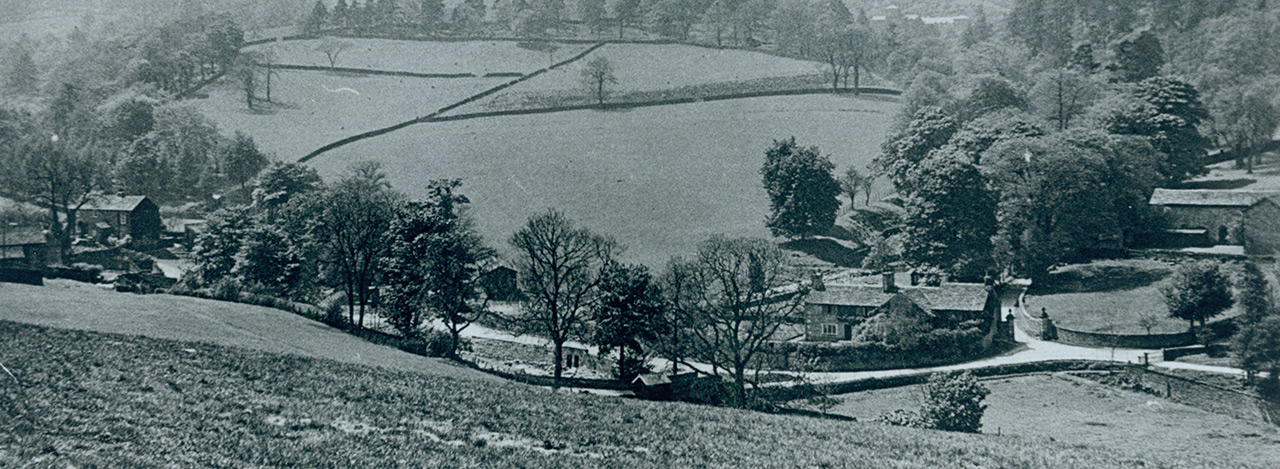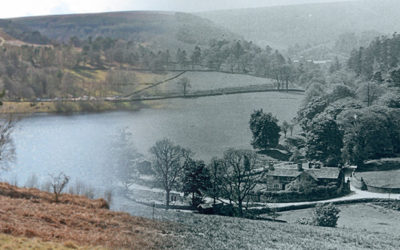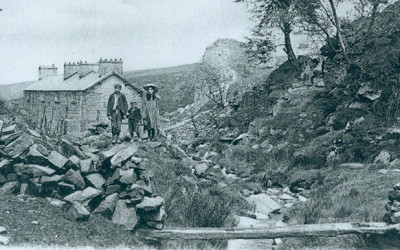
The vanished places of the Goyt Valley
On these pages I’ll include places that were lost following the construction of the twin reservoirs of Fernilee and Errwood. Ranging from the small one-room school which once stood within the hamlet of Goyt’s Bridge, to the large gunpowder factory which now lies beneath the cold waters of Fernilee. Contributions are always very welcome, so please do get in touch.
![]()
Long Hill mystery
Don asks about the foundations which lie just over the fence, coming down from the Long Hill road towards the Goyt Valley. I wonder whether it may once have been a toll house. But who knows?
Fernilee from the air (1934)
A 1934 aerial view of the Fernilee Reservoir construction site reveals some fascinating detail, including the ruins of the Gunpowder Mill, as well as the line of the old Cromford & High Peak Railway.
Castedge spring; then & now
A new ‘then and now’ fade features one of my favourite photos of the Goyt Valley; Kathleen Nall collecting water at the natural spring outside her family home, Castedge Farm Cottage.
New valley panorama
A newly-dicovered photo across the Goyt Valley dating back to the 1920s reveals some fascinating detail – Errwood Hall in the far distance and a possible ice cream kiosk beside Errwood Bridge.
Discovered; a lovers’ walk
In 1880 a writer described “a footpath high above the carriage-way… a lovers’ walk; a deep-green wooded way made for Phillida and Corydon”. My thanks to James for pointing me in the right direction.
Goyt Valley early ’30s #2
A rare view of Goyt’s Bridge, taken in the early 1930s, shortly before all the buildings were demolished following Stockport Corporation’s purchase of the valley to build the twin reservoirs.
Finding the Lodge
Gerald Hancock wrote ‘The Lodge’ on the back of this photo. But I’ve never been able to pinpoint where it was located. Could a lodge marked on an 1888 map of Fernilee provide the answer?
Bunsal Incline bridge
A recently discovered photo shows the bridge over the Bunsal Incline on the C&HP Railway in the late 1960s, shortly before the track was tarmacked to create the main route into the valley.
C&HPR photo: where is it?
Trying to pinpoint the position of a section the C&HP Railway shown in an old photo posed a bit of a mystery. We think it might show a rare view of the track as it heads towards the valley.
Goyt’s Moss Farm
Goyt’s Moss Farm once lay beside the Macclesfield Old Road. It was completely rebuilt sometime after the 1930s and now serves as a Peak District National Park Rangers Information Centre.
The stepping stones
A rare postcard of the stepping stones at Goyt’s Bridge, probably taken around 1910. I hadn’t seen this view before and it reveals some wonderful detail of this most picturesque spot.
Goyt Valley early ’30s #1
A scenic view across The Goyt towards Goytsbridge Farm in the distance. It’s one of a collection of photos of the valley taken in the early ’30s, shortly before the construction of the twin reservoirs.
1930s Goyt Valley photos
“I was going through some old photos dating to 1930/31 and there are several taken at Goyt Bridge. I have never been there myself but my father was involved with it at the time.”
Goyt’s Bridge then and now
I’ve tried to match an old photo of the small hamlet of Goyt’s Bridge with today’s scene across Errwood Reservoir, and merge one over the other. It’s not perfect, but it’s fairly close.
The lost bridge
Goyt’s Bridge, carrying Goyt’s Lane over the stream and one of the most popular picnic places, will be submerged, unless some society wishes to remove it for reconstruction elsewhere…
Goytsclough Paint Mill
The Goytsclough Paint Mills provided employment for around 20 people. Crushed baryte was packed in bags and taken by wagon to be loaded onto the High Peak Railway.
Goytsclough Quarry
Stone from Goytsclough Quarry was used to pave both Regent Street and Oxford Street in London. Today, few signs remain of an industry created in the 17th century by the founder of Pickfords Removals.
Errwood Bridge
“The photo shows a bridge over a stream but seemingly not Goyt’s Bridge. I can sort of remember it, it was a delightful place, the sort my parents sought out for picnics…”
Goyt’s Bridge cafes
“Victorian visitors travelled many miles in their horsedrawn carriages, not just to see the wonderful Goyt Valley in summer, but to admire and enjoy the gardens with their variety and beauty. Then to take tea…”
Castedge Coal Mine
Old OS maps show a ‘Coal Pit’ between Errwood Hall and Castedge Farmhouse. The entrance to the mine has long since been blocked and is now covered by thick undergrowth.



















